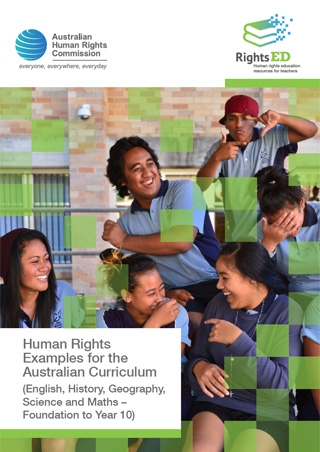Human Rights Examples for the Australian Curriculum

Introduction
The Australian Curriculum provides a rich opportunity for children and young people to learn about their human rights and the importance of respecting the rights and freedoms of others.
Educating people about human rights is a way of protecting fundamental freedoms, like freedom of speech. It also helps to address discrimination, harassment and violence because of someone’s race, age, gender, disability or their sexuality.
The importance of human rights education is recognised in a number of human rights treaties including the Convention on the Rights of the Child. Human rights education is a right in itself. But it’s also a way of protecting human rights.
Human rights education enables students to learn from Australia’s history and proud record on human rights. It is a way to build an equal, respectful and inclusive Australia that values human rights. Human rights education gives all students a foundation to build a culture of respect for human rights. This provides both knowledge about human rights and the laws that protect all people and helps students gain the skills needed to promote, defend and apply human rights in daily life.
Human Rights Examples for the Australian Curriculum aims to provide a guide for teachers to identify practical opportunities through the Australian Curriculum, to teach human rights-related content.
Human Rights Education can change attitudes, build empathy and motivate participation. All of these can help to build a more equal, respectful and inclusive Australia.
We hope that Human Rights Examples for the Australian Curriculum will be an inspirational and useful tool to help identify many of the opportunities that the Australian Curriculum provides for teaching students about the promotion and protection of human rights both in Australia and globally.
Gillian Triggs
President
Australian Human Rights Commission
Human Rights Education in the Australian Curriculum
The Australian Curriculum provides many opportunities for students to learn about human rights in a range of contexts, at all year levels, across all key learning areas and through the general capabilities and cross curriculum priorities.
This mapping identifies some of the opportunities from Foundation to Year 10 in the key learning areas of English, History, Geography, Science and Maths. As other curricula are finalised, further mapping of human rights will occur. This mapping aims to provide useful examples for teaching human rights to students. We welcome further examples and feedback on how school communities are effectively teaching human rights through the Australian Curriculum.
How to use Human Rights Examples for the Australian Curriculum
The human rights in the Australian Curriculum mapping is designed as a guide for teachers to provide human rights related examples that are consistent with key learning area content descriptions. Each human rights example is mapped by key learning area, year level, code and content description so teachers can easily identify possible human rights content for their programs.
There will also be many human rights related examples in the existing content elaborations and many of the human rights examples complement these.
To provide ease of use for year level primary teachers and subject specific secondary teachers the mapping is organised slightly differently at the primary and secondary level:
Primary
In the primary years, human rights content is organised by year level so that a teacher can identify teaching opportunities across all key learning areas within their classroom context.
Secondary
In the secondary years, human rights content is organised by key learning areas so that subject teachers can identify teaching opportunities across their learning area from years 7 – 10.
